Learn all about Pacman frog care from the world's most prolific breeder of these impressive amphibians, Sam Sundberg of
The Frog Ranch. This is the definitive guide to their care.We deep-dive everything from habitat to handling, and include specific photographs depicting much of what's discussed.
You'll quickly see that caring for this horned frog species is easy when done correctly, making them a very rewarding pet.
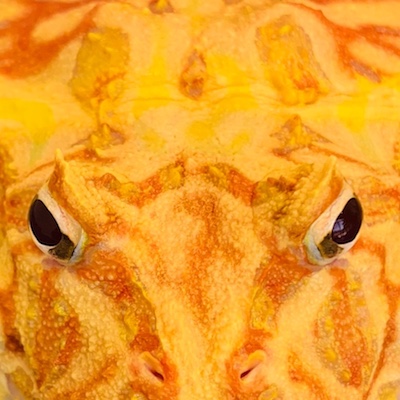
Adult breeder albino pacman frog
Pacman Frogs
(Ceratophrys cranwelli)
Introduction
Pacman frogs (Ceratophrys cranwelli) are undoubtedly one of the most impressive, crowd-pleasing frogs in the world. Their huge size, insatiable appetites, and colorful appearance are truly astonishing. If you haven’t experienced the excitement of feeding time, you’re missing out.
My name is Sam Sundberg, owner of The Frog Ranch, Inc. here in Idaho. We’re the largest amphibian breeding and research facility in the world. We’ve spawned and raised tens of thousands of Pacman frogs, as well as many other remarkable horned frog species.
Ceratophrys cranwelli, pronounced (ser-rat-uh-fris cran-well-eye), is the scientific name of this frog species. The reason scientific names are important is because some frogs go by several “common” names, but there’s only one scientific name. For instance, Pacman frogs are also known as Cranwell’s horned frogs.
Pacman frogs are affectionately named after the 1980’s video game character Pac-man, because they appear to be all mouth, and gobble up everything in front of them!
It’s my belief that this species makes a fantastic pet in captivity, and I’ll detail all the information you need to know to successfully raise your frog. I’ll also debunk myths, and pass along care information based upon decades of experience.

These horned frogs originate in South America, specifically, Argentina and some bordering countries. Here’s a range map you can check out. They’re found in what’s called the Gran Chaco region, which is actually a harshly dry area for most of the year.
The Gran Chaco area receives up to 52 inches of rain annually, but nearly half of that occurs in the Summer, meaning there are periods of great flooding and high evaporation. The average temperatures range from 59F to 80F, but maximum temperatures can exceed 100F+.
Virtually all Pacman frogs available in the United States are captive bred, which is great. Even so, their wild populations are ranked as Least Concern according to the IUCN Red List.
Estivation
Speaking of dry areas, did you know that in the wild Pacman frogs spend several months each year buried in the dirt? The frogs do this, as you probably suspected, to protect from desiccation (drying out). It’s called estivation.
When Pacman frogs sense drier conditions, they’ll start producing layers of transparent “skin” which seals them inside a membrane that prevents them from losing much moisture. They can remain in their “cocoon” for months with no adverse affects. As soon as water is re-introduced, they tear out of the membrane.
Estivation is something these frogs can do any time of the year in captivity, it’s not just seasonal like it is in nature. If you inadvertently allow your frog to get too dry, don’t make the mistake of thinking it’s dead.
Pacman Frog Terrariums and Enclosures
In case you haven’t already picked-up on it, these frogs are terrestrial, not aquatic. They can easily drown if placed into water that’s too deep. If you’re keeping your frog(s) in a setup that’s got standing water, you need to make sure they can always easily touch the bottom at all times.
But, since they’re not aquatic amphibians, there’s really no reason your Pacman frog should be placed into an aquatic or semi-aquatic cage. I’ve learned through the years that most people have in their mind this unshakable belief that frogs are amphibians, and amphibians need tons of water.
Horned frogs just don’t need much water to be kept successfully in captivity.
This species can very adequately be kept in a simple 10-gallon tank for the duration of its life, which makes these frogs ideal captive specimens.
Substrate-wise, damp peat moss to a depth of 4-5 inches is ideal. What does “damp” mean? This would mean if you grab a handful of the peat moss and squeeze, just a little water would drip out. Not much, just a little. You don’t want your frog sitting in soaked substrate.
Peat moss has the advantage of having higher acidity and is naturally anti-bacterial to a certain extent. It’s also easy to burrow into, which your Pacman frog will appreciate.
Damp soil will provide all the humidity your frog requires. The cage will need to have decent ventilation, but not too much. If there's not enough air flow, you'll know because condensation will appear on the walls of the terrarium. If there's too much ventilation, you'll know because the peat will dry out quickly.
Screen tops can work, but aren't ideal, as they let a lot of humidity and heat escape the enclosure.
Let’s circle-back to the subject of water. I’d recommend including a shallow water dish sunk into the substrate so that it’s essentially even with the surface of the substrate. How shallow? Right around a quarter-inch to a half-inch for baby frogs, and around an inch or so for adults. Make sure your frog can climb out easily.
The diameter of the water dish should be 4-6 inches for baby and juvenile frogs, and closer to 8-inches for adults.
You may at times find very small, cylindrical whitish eggs in or around the water dish—these are just cricket eggs, so don’t worry, they’re not internal parasites being excreted by your pet.
I once had a customer contact me saying her solitary female Pacman frog had laid eggs that hatched in its water dish, and incredulously asked how it was possible she had produced tiny tadpoles without a male. I asked for a picture. Mystery solved—they were mosquito larva.
The water dish will likely be used fairly often, so it’s really important that you clean it often. I’d recommend every day, but at least every other day. I like to use a safe, non-toxic disinfectant such as Virosan, Dermachlor, or F10SC.
But, you can use a 95% water, 5% bleach solution as well—just make sure you rinse the water dish really well before putting it back into the terrarium.
These frogs of course don't "drink" water, but they do absorb it into their bodies. It's vital that the water be clean—it's of paramount importance.
Pacman frogs prefer warm temperatures, preferably in the 78F to 82F range. This is best accomplished using an under-tank heating pad in my experience. You can attach the heating pad to all or part of the underside of the enclosure. Juveniles like being a little warmer, around 80F to 85F or thereabouts.
If you want to be on the safe side, just attach the heating pad to half of the external bottom of the enclosure. This way, if there’s a malfunction and it overheats, it won’t threaten the frog’s life. The frog can simply escape to the cooler side of the cage.
Getting a quality heat pad with a built-in thermostat is recommended. This way you can set it to the exact desired temperature. Every reptile or amphibian keeper should have a temp gun.
If your frog isn’t eating well, make sure the temperature is high enough. Temperatures below the optimal level are the most common reason they don’t eat. Lower temperatures also weaken their immune system.
Keep in mind that when you heat a portion of the substrate, it’s going to lose moisture much more rapidly. Keep an eye on the saturation level and add water when necessary to maintain damp conditions.
So, you now have the essentials: a 10-gallon enclosure, damp peat moss as a substrate at a depth of around 4-5 inches, a shallow water dish, and an under-tank heating pad. The rest is really aesthetics and totally up to your own tastes. A hide spot may or may not be used—they usually prefer just digging a shallow cavity with their back feet.
You can spruce up your frog's habitat with live plants, but they may be unearthed by burrowing. If you do choose to use living plants, make sure they're non-toxic and don't have pesticides on them.
Pacman frogs don’t require UVB lighting. Period. In fact, ultraviolet rays can damage their eyes since they essentially sleep/rest with their eyes open when above ground. When they are burrowed into the substrate, they will often close their eyes, but not always.
Any (non-UVB) lighting is provided simply for the proper maintenance of a day/night cycle (12 hour day / 12 hour night is fine), and for viewing purposes. Keep in mind, these frogs are nocturnal, so they don’t get much (if any) sunshine in nature.
These voracious beasts are ambush predators, which means they sit-and-wait for unsuspecting prey to wander across their path. This is why they don’t need much space to exist—they’re not very active. But, feeding time could be described as lightning fast and aggressive.
Feeding Pacman Frogs
This is the really fun part!
Pacman frogs will eat just about anything you offer them, as long as it’s moving. This means it’s your responsibility to manage their diet properly, making sure they’re consuming nutritious and well-balanced feeders.
Juvenile frogs should be offered gut-loaded insects about every other day, and a pinkie mouse once per week or so. We’ve had great success raising our frogs on this diet.
If you don’t have access to live feeder pinkie mice, you can purchase frozen mice and offer them to your frog with tongs. Rub or tap the pinkie a few times on the frog’s mouth if it’s reluctant to eat it.
In my experience, once juveniles taste a pinkie, they’ll continue eating pinkies ravenously in the future. Sometimes you have to convince them the first time though, since they’re used to eating insects and smaller feeders.
The best insects for your Pacman frog to eat include crickets, mealworms, roaches, and waxworms. In my experience, crickets work really well as the main diet, making up around 75% of the menu. Make sure you're gut-loading the insects about 15 minutes prior to feeding with one exception, waxworms, since they don't eat. Vit-All from Sticky Tongue Farms is the best gut-loading product we've used.
Mealworms, roaches, and waxworms make up the remainder of the diet, for purposes of a little variety. But, crickets alone is absolutely sufficient if you’d rather keep things simple. Just remember to gut-load. Even baby Pacman frogs can easily handle medium and adult crickets. Remember—these frogs can eat each other, so a cricket isn’t exactly a challenge!
Once a Pacman frog reaches about 2-inches snout-to-vent length (ie. excluding the legs), I start feeding them pinkie mice more often, maybe 50% of their diet, with the remainder being primarily crickets and roaches.
This feeding regimen allows them grow quickly and provides them with the calcium and nutrients necessary for strong bone formation, thus preventing malnutrition.
I feed juveniles about once per week, sometimes twice.
A good rule of thumb is never feed your frog a feeder that’s more than 50% of its body volume. That might sound ridiculous, but I’ve had frogs attempt to eat frogs bigger than themselves (see picture below).
To you and I, this seems preposterous. But these frogs are voracious eaters, and they have no qualms about trying to consume something much bigger than themselves.
Sometimes, this results in the death of both the frog, and whatever it was trying to eat.
This brings up an important facet of Pacman frogs—they can be fairly cannibalistic. They just love to eat each other if given the opportunity.
Never take for granted their ability to swallow a cage mate. Yes, you can keep two in one enclosure, just remember to keep them well fed, give them space, and don't allow there to be a large size difference. When they're approximately the same size, it's generally safe.
Whether you’re talking about babies or adults, breaking their line of site can greatly reduce frog-on-frog cannibalism. In other words, build-up the substrate between them, or put a plant between them, a branch, etc.
I once saw three juvenile frogs in a row, one trying to eat the other—the one that was being eaten had a frog in its mouth as well. You can’t make this stuff up.
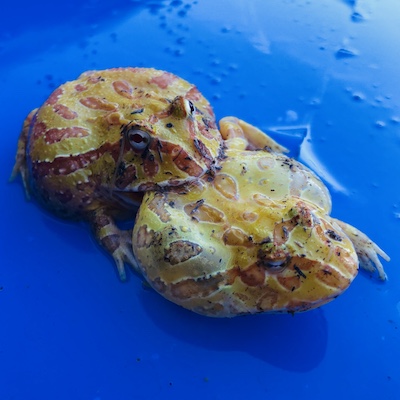
A common sight when Pacman frogs are kept together
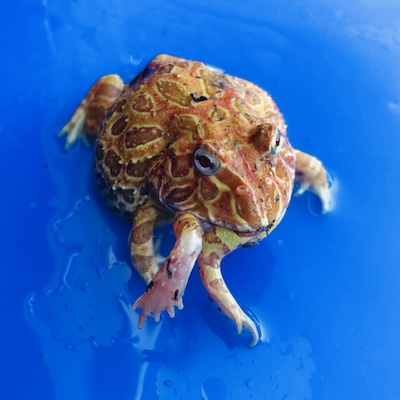
It's a frog-eat-frog world
Ok, back to feeding your Pacman frog.
I feed adult frogs a medium thawed mouse about every three weeks. I’d recommend using tongs to prevent getting bitten, but I just use my fingers because I have particularly fast reflexes. I’ve had to act quickly to avoid a bite many times. They may look slow, but they’re lightning fast at feeding time. They’ll jump at the food too.
Sometimes I get asked if live mice are healthier feeders when compared to thawed mice. I’m sure there are some nutritional benefits to feeding your frog live mice, that seems logical, but the negatives outweigh the positives in my personal opinion.
Why? Because live mice can bite your frog.
I know it’s more fascinating to watch your Pacman frog eat live mice, I totally get it. I do. I also don’t have an ethical issue with it.
Live mice can hurt your frog in two ways, which is why I no longer feed live mice to my breeders.
First, if the mouse gets grabbed from the rear, it will almost always turn around and start gnawing on the frog. This can lead to cuts that get infected.
Second, if the frog doesn’t eat the mouse right away, the mouse can chew on the unsuspecting frog at night if it’s hungry.
I’ve witnessed both of these scenarios plenty of times.
But, if you decide to feed live mice, just remember to remove the mouse if it’s not eaten within a couple hours, and try again in a day or two.
Never feed your Pacman frog insects from outside. Nowadays, with pesticides everywhere, just don’t risk it.
Pacman frogs have very sticky tongues that they use to latch onto prey and bring it into their mouth. Sometimes they’ll inadvertently strike the side of the enclosure and you’ll get a good view of just how sticky their tongue is as it slowly peels off the side of the glass.
Some Pacman frogs will occasionally go on a long hunger strike, and then start eating normally again after several weeks. It’s disconcerting when it happens, and not every frog does it, but don’t be alarmed as long as the frog otherwise appears healthy. Just continue offering food at regular intervals until your frog snaps out of it.
Once in a great while—and this doesn’t happen very often—a Pacman frog will raise its rear leg(s) up and start wiggling its feet and toes. The first time I saw this I immediately thought it might be a neurological disorder, and then I realized it wasn’t. It’s actually a very deliberate display to attract prey! It’s similar to an Alligator snapping turtle wiggling its tongue to attract fish—same concept. It's called "pedal luring."
My frogs do this occasionally when I enter their room, both babies and adults. I suppose they’re intelligent enough to know that either 1.) I bring food or 2.) I’m moving and they think they can lure me in. Either way it’s really fascinating to watch.
Pedal luring by Ceratophrys cranwelli
Horned Frog Supplements
Supplementing your Pacman frog’s food is important for a variety of obvious reasons, but it’s most important for juvenile frogs, since they grow very quickly. If your frog isn’t growing quickly, something’s not right.
Think of it this way—feeding your juvenile frog the same feeder insect week after week is going to leave it deficient in certain vitamins and minerals, not the least of which is calcium. Just like if you or I consumed broccoli for every meal. We’d get some nutrition, but we’d be missing plenty too.
The supplement I have used successfully for two decades is Miner-all indoor. It contains human grade calcium, vitamin D3, and many trace minerals. It’s also ground very fine, so it adheres really well to any feeder insect or rodent.
A general rule that’s served my baby and juvenile Pacman frogs well is to use Miner-all indoor with every other feeding, and we use Vit-All to gut-load all feeder insects for 12-24 hours before feeding them to the frogs. Vitamins ingested by the feeder insect are more usable for your frog than vitamins dusted onto feeder insects.
The big risk of forgetting to supplement is of course malnutrition, which leads to all sorts of issues including weakness, metabolic bone disease, neurological disorders, and deformed features.
It’s so affordable, there’s no reason not to supplement. Just put a small amount in the feeding bucket with whichever insects you have available, and shake. That’s it.
Pacman Frog Size
Pacman frogs attain massive sizes, some going well over one-pound in weight. Genetics play a role in how big they get, but so does their sex.
Even though they’re not sexable as juveniles, if you want a big frog, you’ll want to get a female. As adults, females are about twice the size of males. Males can croak, and females don’t.
You can almost always immediately identify an adult male because their throat skin will look like it’s been stretched, making it look a little loose. The loose skin, as you likely guessed, is the result of croaking. Their throats are usually darker in color as well. Adult males also have a nuptial pad on the inside of each front leg near the base of the toes. This helps them hang on to females during mating.
Males generally top-out at about 3-4 inches snout-to-vent, and females around 4.5 to 6 inches.
I have a giant adult female albino that’s six inches snout-to-vent, with a width of about six inches as well. She’s just gargantuan, the biggest of all my Ceratophrys cranwelli.
Handling Horned Frogs
Their huge size also means their bite packs a punch. One study demonstrated that large Ceratophrys frogs can produce a bite force of approximately 500 N (Newtons), which is roughly equivalent to the pressure of 13.5 gallons of water sitting on your hand, which would weigh 112 pounds!
As if that weren’t enough, check out the below picture showing a Pacman frog’s teeth (upper jaw only—their bottom jaw has two large teeth near the middle). They’re recurved! The black scale bars indicate 1mm in width.
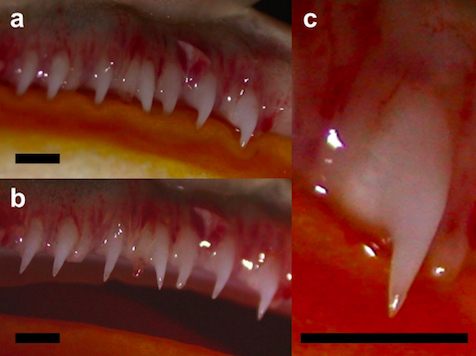
Photo credit: A. Lappin, et al, Bite Force in the horned frogs (Ceratophrys cranwelli), 2017 Scientific Reports
So, you can handle your frog, but you always need to know where your fingers are! When you’re holding one, pay close attention because they can seem calm but suddenly attempt to jump out of your hands, with no regard for how far they’ll fall.
If you need to pick one up, I recommend grabbing them gently but firmly around the base of their rear legs.
Like all reptiles and amphibians, these frogs tolerate handling, but they don’t enjoy it.
Pacman Frog Health
A few of the most common health issues for Pacman frogs include obesity, edema, red leg, and malnutrition.
Obesity is extremely common with these frogs, because they have insatiable appetites. It’s important to remember that in the wild, they’re programmed to eat whenever the opportunity presents itself. They’re only active for a portion of the year and they have to bulk up for breeding season.
In captivity, they’re presented with endless amounts of prey, and it can quickly lead to obesity. Now, I’ve never seen a juvenile that was obese—they have a way of simply applying the extra calories to remarkably rapid growth. But adults can easily become overweight in a matter of a few months.
Obesity is dangerous to their health for obvious reasons, and it’s entirely avoidable, so just pay attention to your frog’s weight and scale back the food if necessary.
Edema is very noticeable. It’s what I call edema anyway. Their skin will look swollen with fluid, mainly in their rear legs, but it can be on the sides of their body as well.
It’s basically irreversible in my experience, but it generally takes quite a while for the frog to perish—sometimes well over a year. Oddly enough, during this time, they'll continue to eat and act normally. Below are a couple pictures so you can see what I'm talking about.
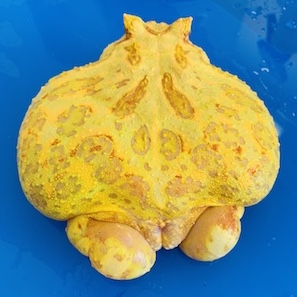
Notice the retained water in the rear legs.
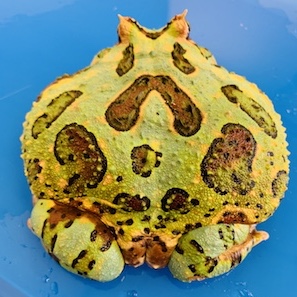
This frog has one leg showing signs.
Red leg syndrome is almost always associated with non-sanitary enclosures. If you keep your Pacman frog’s setup clean, you really shouldn’t have any issues with red leg. I can’t prove this scientifically, but I tend to think the causes of red leg are ever-present, and they only multiply to dangerous levels in a dirty enclosure.
There was once a product that purported to eliminate red leg by introducing bacteria that would outcompete the red leg bacteria for food, but it appears to be off the market, and I was never able to procure any.
We touched on malnutrition earlier in this article, and it’s pretty self-explanatory. Offering your frog the same food items repeatedly, with no supplementation or gut-loading, can lead to this condition. It's like if you just ate apples for every meal. Apples are healthy to eat, but if it's all you eat then you'll be deficient in certain things.
Malnutrition will lead to stunted growth and, not surprisingly, can become lethal if allowed to progress for very long. It’s easy to avoid by keeping your frog well fed, varying the diet, gut-loading, and properly supplementing feeder items.
Impaction is definitely something to watch out for—this is when a frog swallows something that’s not digestible such as gravel, wood, etc. I’ve had quite a few baby Pacman frogs that have completely swallowed small sticks of wood (the kind that can be found mixed in peat moss) as long as their body.
Lastly, if your frog has its eyes closed for long periods of time, start watching closely for environmental or health issues. Sometimes its from ammonia in their environment, which would mean you need to keep the terrarium cleaner.
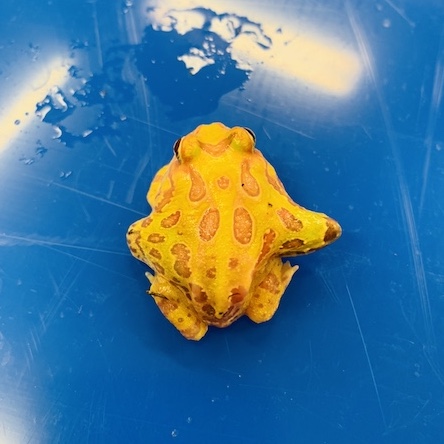
One of my baby albino Pacman frogs that swallowed a twig
Pacman Frog Facts
Pacman frogs are nocturnal, but they’re happy to eat any time, day or night.
Their colors and patterns change as they mature. So, adult frogs often times look much different than they did as babies. Brown frogs can turn green, and vice versa. Also, patternless frogs can develop patterns.
Pacman frogs are polygenic. This means their genetics are a little like humans, in that the offspring won’t necessarily have the appearance of the parents. Size and coloration can be influenced by several genes, so the appearance of the babies isn’t predictable like in many snake species.
Interestingly, the vast majority of wild Pacman frogs are brown, not green.
Locals in South America call Pacman frogs “escuerzos” and they erroneously believe that they’re venomous, and that they actually attack and kill cattle.
I'm proud to say that the albino morph was first produced by The Frog Ranch in 1992, and continues to be the most popular variant of Pacman frog in the pet trade.
The average Pacman frog lifespan, with good care, is 5-10 years. Regardless of anything you read, that’s what I’ve observed—these are long-lived amphibians. I have some Ceratophrys cranwelli that are over ten years old and going strong.
Pacman frog tadpoles communicate with each other via high frequency sounds, something researchers think is to prevent cannibalism. In other words, it’s a way to say, “Hey, we’re siblings, please don’t eat me!” In reality, if food is scarce, I can tell you from experience that the tadpoles ignore this communication and obliterate each other.
Tadpoles will sprout their back legs first, and then their front legs shortly thereafter. They then spend a few days absorbing their tails before completing their metamorphosis into small frogs.
Horned Frog Price Range
Fortunately these frogs are really affordable pets, with the very popular greens and albinos generally retailing for around $20 each. The various Ceratophrys cranwelli color and pattern morphs are a bit more expensive—here are a few that we currently produce at The Frog Ranch:
Green
Albino
Chocolate
Camo
4-Spot Patternless Green
4-Spot Patternless Albino
Strawberry
Strawberry Pineapple
Apricot
Mosaic
3-Stripe
Leopard
Mint Green
Albino patternless
All of our frogs are bred and produced in our state-of-the-art facility in sunny California. We obsessively focus on cultivating unparalleled genetic lines, producing unmatched color morphs, and maintaining a sanitary facility free from disease. If you buy your own Pacman frog, make sure it's not one of the many inferior asian imports currently flooding the market. If you're unsure, ask your retailer if they're buying from The Frog Ranch. If you're purchasing from Backwater Reptiles, you can rest assured your new pet was bred by us.
If you're interested in buying wholesale Pacman frogs, feel free to e-mail me me for a price list. There are minimum order requirements. We are licensed by USFW to ship internationally as well.
Make sure to avoid Pacman frogs imported from Asia—they're weak, underfed, and unhealthy. Always ask if your frogs were bred in the United States, or even more specifically, at The Frog Ranch.
Conclusion
I really believe that Pacman frogs make the best pets of all the myriad frog species. Sure, dart frogs are fun, but they're tiny and fragile. There are some phenomenal tree frogs out there, but it's usually challenging to handle or interact with them. Bullfrogs and Leopard frogs are flighty and incessant jumpers.
Pacman frogs are a blast to feed, their care requirements are minimal, they've got long lifespans, they're easily observable terrarium pets, and their vivid colors and patterns are always unique. What more can you ask for in a pet frog?
Sam Sundberg, owner
The Frog Ranch, Inc.
Copyright 2023 Backwater Reptiles, Inc.














